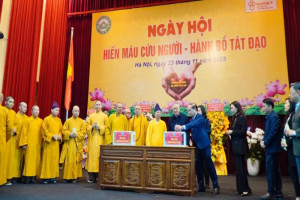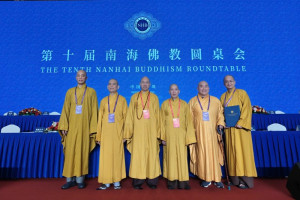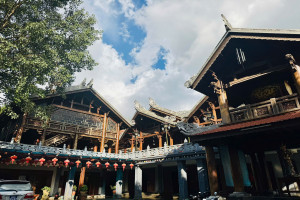
During the entire course of Vietnam’s history, especially during the two protracted and heroic Wars of Resistance Against Foreign rule and aggression in general, patriotic followers of various religions contributed in remarkable ways to Vietnam’s revolution for independence and unification of the Homeland. Since reunification, religious followers have continued the work of national development under the motto, "For better secular and religious life".
Reviewing the country’s history during the struggle to protect the Homeland and during the times of peace, one can affirm: Followers of different religions have significantly contributed to the struggle for independence and unity of the entire Homeland. Many religious followers achieved important feats and are regarded as good examples for future generations. Religious people constitute an integral part of the Vietnamese community and have actively contributed to implementation of Vietnam’s policy of great national unity as well as to the cause of Reform, Renewal in order to bring about greater prosperity and happiness to the nation and people.
Religious organizations are among the forces that responded to and supported the movement of patriotic emulation from the beginning. They proposed specific action plans and issued appeals, public letters, and announcements to mobilize senior religious leaders, members of religious orders, and followers to join.
During recent years, thousands of religious households have achieved good results in hunger eradication, poverty reduction, economic development, and implementation of cultural and economic development policies in the course of building sound and strong localities. During the past five years, over three million registered religious households from across the country have engaged in agricultural production; over two million of these households have been recognized at the local level as successful in farming production and small business, with many organizations and individuals recognized as outstanding. Religious followers have restored many traditional craft villages, creating wares of high quality and jobs for tens of thousands. They have carried out various credit programs focusing on the poor and have helped many poor families overcome poverty.
People across the country unite in promoting their long-standing ethical tradition, “Repay a kindness” and “When drinking water, remember its source",. Religious followers always show readiness to take part in charitable social work, in disaster relief operation. Many clerics have made oustanding contribution to such movements as: “Open the Golden Book of Piety” and “Build Houses of Gratitude, Houses of Compassion, Houses of Great Unity, and Gardens of Gratitude” to care for heroic mothers who lost their children during the war. They have contributed freely from their own assets to help poor children, orphans, and the elderly without support. Many care centers belong to religious organizations. There, senior religious leaders and monks and nuns are not afraid of hardship or of the danger of catching diseases. They voluntarily devote their efforts and money to care for patients with HIV/AIDS, leprosy, infectious diseases, and dermatological ailments. They are especially attentive to poor patients. Many Catholic churches and Buddhist pagodas have been active in raising orphans and caring for hundreds of AIDS patients who are in the disease’s final stages and who have no family support.
The Vietnamese Buddhist Sangha, the Cao đài Church, the Hòa Hảo Buddhist Congregation, and other religious organizations have established hundreds of medical clinics to provide free services for the poor. They contribute tens of billions of VND each year to support victims of natural disasters and hundreds of billions of VND to other social and humanitarian activities, including: Support for improvement of production; construction of bridges and roads to ease transportation difficulties for people in remote areas; support for patients with mental illness; care centers for lonely elders and orphans; and humanitarian blood donation.
These humanitarian activities, which are effective and appreciated, have arisen from the movement, “Repay a kindness", which in itself arose from the nation’s tradition of unity, affection, and mutual assistance with a spirit of “The intact leaf shields the torn one” and which also arose from the noble tenets of various beliefs and religions.
Religious followers have responded to the movement, “Develop Cultured Lifestyles in Residential Areas", and have often received titles such as “A Cultured Religious Establishment” and “A Cultured Family". Many Buddhist religious organizations have programs and concrete plans for response and participation similar to the movement to establish “Outstanding Pagodas” or “Cultured Pagodas” among the Buddhists. Catholics in many localities have interesting initiatives and have set up content and specific standards allied with their religious principles and lifestyle as they encourage religious families to achieve the title “Outstanding Parish” or “Model Catholic Family".
“Cultured Villages” and “Cultured Streets” have emerged in many provinces and cities across the country with features of a principled lifestyle and harmonious life and with many models showing initiative in the movement to build a new countryside and a new personal outlook. Numerous residential areas in regions with many religious followers have become good examples in the fight against crime, drugs, and other social ills in the effort to retain and maintain social order and provide personal safety. Religious leaders and followers of religions have actively opposed social ills through use of their religious teachings, tenets, creeds, and moral lifestyles.
Many models for production and social work have arisen from the emulation movements, leading to the contribution of both labor and property to the development of localities and the country at large. Previously, some residential areas with religious followers had limited access to education, family planning, and public health services … and there have since been many positive changes in these areas. Areas with many religious believers show a low incidence of social ills.
Unity to expand democracy and implement the Regulations on Grassroots Democracy have created an atmosphere of enthusiasm and confidence among the people in general and particularly in areas with many religious followers. The process of expanding implementation of the Regulations has created more trust among religious followers in the leadership of the Communist Party of Vietnam, in the process of Renewal, and in the role of citizens as masters of the country. Citizens have seen more clearly their rights and responsibilities in building and protecting local administrations that are transparent, sustainable, and truly of the people, by the people, and for the people effectively implementing the movement, “All the people unite to build residential areas with cultured lifestyles” while realizing socio-economic goals and the duties of public security and national defense in building and protecting the Homeland so that Vietnam can become stronger and more prosperous.




